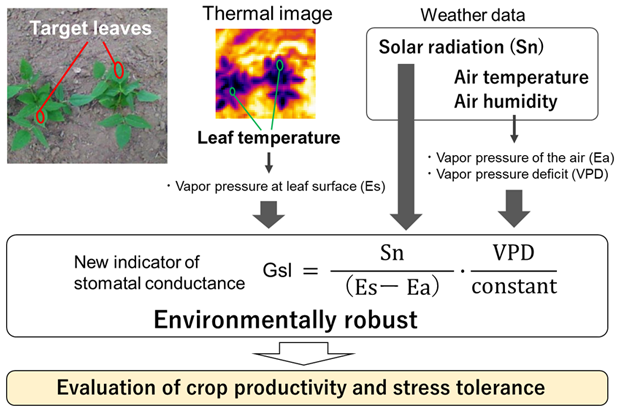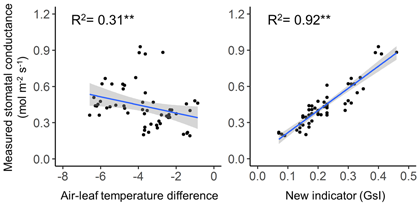A new indicator of leaf stomatal conductance based on thermal imaging
Description
Stomatal conductance is a major regulator of water vapor and carbon dioxide exchange between the leaf and the surrounding air, directly affecting plant growth and leaf water status. To rapidly evaluate the stomatal conductance, indicators from infrared thermal imaging are available as an easy and simple method. However, a difficulty with these indicators is that the relationship between leaf temperature and stomatal conductance may vary strongly with variations in solar radiation, air temperature, humidity, and wind speed, and thus it is difficult to estimate stomatal conductance from leaf temperature over a wide range of different meteorological conditions.
In this study, a new indicator of stomatal conductance (GsI) with environmental robustness was developed. This indicator is calculated from leaf temperature and other meteorological variables of solar radiation, air temperature, and relative humidity (Fig. 1). The equation is the result of a modification of the theoretical equation of stomatal conductance, simplified by making several assumptions. To validate the robustness of the GsI under varied meteorological conditions, thermal image was obtained for cowpea plants every week from two to eight weeks after sowing. Four cowpea varieties were grown at the experimental field of the International Institute of Tropical Agriculture (IITA) in 2016 and 2017. Compared to the existing indicator of stomatal conductance (air-leaf temperature difference), the GsI showed stable relationship with measured stomatal conductance using leaf porometer over the different meteorological conditions (Fig. 2).
GsI was calculated using a simplified equation with four variables, namely, leaf temperature, air temperature, relative humidity, and solar radiation. Except for leaf temperature, all other variables can be obtained from continuous-measurement devices installed near the field; thus, an evaluator only needs to take a thermal image for each measurement. As GsI calculation does not require any reference temperature, the time for photographing is much shorter than that for evaluations with reference temperatures. Therefore, this new method is suitable for rapidly evaluating a large plant population, such as a set of genetic resources and cross-populations, for genetic analysis.
Although the relationship between GsI and measured stomatal conductance is stable for varied meteorological conditions, there are precautions for its application. First, the GsI is not suitable for plant leaves with different angles because the relationship between thermal image and actual temperature differs depending on the leaf angle. Second, GsI should not be applied to leaves having extremely low stomatal conductance such as under severe drought conditions or deeply clouded conditions. This is because the equation of GsI is premised on the occurrence of transpiration at leaf surface. Determination of stomatal conductance using GsI with the above precautions provides important physiological information related to plant responses to the environment, and will help identify superior genotypes with high adaptability to specific target environments.
Figure, table
-
Fig. 1. A new indicator of stomatal conductance (GsI)
-
Fig. 2. Relationships between indicators based on thermal imaging and measured stomatal conductance. Gray area represents 95% confidence interval of the regression line.
- Affiliation
-
Japan International Research Center for Agricultural Sciences Biological Resources and Post-harvest Division
- Classification
-
Technical A
- Research project
- Program name
- Term of research
-
FY2019 (FY2016-FY2020)
- Responsible researcher
-
Iseki Kohtaro ( Biological Resources and Post-harvest Division )
Olaleye Olajumoke ( International Institute of Tropical Agriculture )
- ほか
- Publication, etc.
-
https://doi.org/10.1080/1343943X.2019.1625273
Iseki K and Olaleye O (2019) Plant Prod Sci, 23(1):136-147
- Japanese PDF
-
2019_B02_A4_ja.pdf770.87 KB
2019_B02_A3_ja.pdf253.56 KB
- English PDF
-
2019_B02_A4_en.pdf660.37 KB
2019_B02_A3_en.pdf227.77 KB
- Poster PDF
-
2019_B02_poster_fin.pdf419.96 KB


